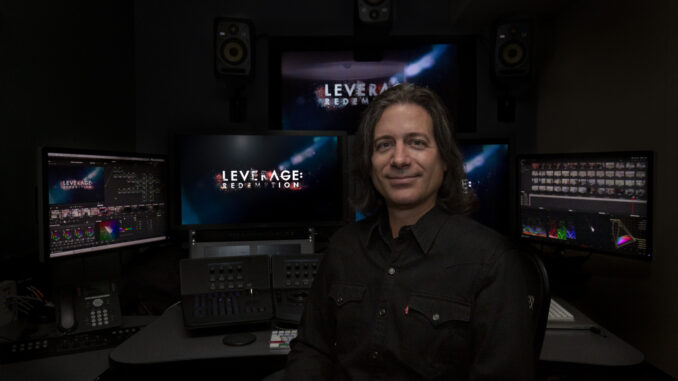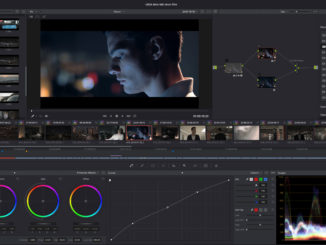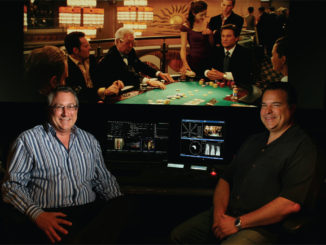
CLASSIFICATION
Finishing Colorist (CSI (Colorist Society International), Dolby Vision Certified, SMPTE)
Q Where are you currently employed?
I’m at Electric Entertainment, an independent studio. Dean Devlin, Rachel Olschan-Wilson, and Marc Roskin are co-founding partners . What an amazing company with a great support team. Every show is created in-house Hollywood style, from script to screen. They also have their own streaming platform, Electric Now.
Q Current projects?
I recently finished coloring the third season of “The Outpost,” a fantasy-adventure series that airs on The CW, and “The Deal,” a feature film set in a dystopian future. I also completed the series “Almost Paradise,” starring Christian Kane, about a former DEA agent in the Philippines. I’m currently working on “Leverage: Redemption,” a re-boot of the original “Leverage” drama series, this time starring Noah Wyle, and with Aldis Hodge and Gina Bellman who were in the original show. It’ll be one of the first original series to premiere on IMDb TV.
Q Describe your job.
First and foremost, my job is to understand the vision and tone of the director and director of photography of a project. I start by watching a few scenes to get into the story and then get to grading. First I balance all of the shots within one scene then I adjust the color for mood or style while also managing color for consistency with the rest of the project. I find it helpful to listen to the sound during this process to get a feel for mood, blocking, and the action in the scene. I grade everything in a Color Managed Dolby Vision workflow, creating both HDR (High Dynamic Range) and SDR (Standard Dynamic Range) versions simultaneously. This was a little daunting in the beginning, but now it’s just second nature to me. From the QC (quality control) approved Dolby Master, any requested deliverable can be created. I’m always finding ways to refine the grading process. The more efficient I can be, the more time I’ll have to be creative. I spend a lot of time reading, trying new techniques, and bouncing ideas off of other colleagues in the industry.
Q How did you first become interested in this line of work?
In high school, I took all the advanced science and art classes. A buddy and I would finish our six-week projects in one week and would end up disrupting class by playing paper football. One day, our teacher finally got fed up. She grabbed her entire set of her college books on Color Theory, slammed them on the desk in front of me, and yelled “Here, read these!” These books changed my perspective on everything. Thank you, Miss Dandridge.
Early in my career, I was editing TV commercials when the director I was working with, Robert Williamson, took me to my first grading session. I had never seen images with such clarity! By my third session, Robert liked my vision and trusted me to work with the colorist, Steve Franko, on my own. I asked Franko if I could come up to the console. He gladly walked me though the process, and I couldn’t believe how much control he had of the final image. This was an experience I’ll never forget.
Q Who gave you your first break?
I knew I really wanted to make movies and TV series. A good friend of mine, Matthew Spradlin, gave me a chance when I asked to work on his short. He literally showed up with a shoe box of bare, full-sized hard drives and his wadded-up shooting script. He said, “Here, make a movie.” I edited, scored, mixed, and graded the film “The Social Contract,” which went on the be accepted into multiple film festivals — most notably, Festival de Cannes.
Q What was your first union job?
Sound designing and mixing hour-long TV shows, such as “Attack of the Show!” It all had to be done in real-time, laying and mixing effects tracks for a scene that had already been mixed for dialogue. I only had two passes, then the producer would come in for the third pass to make changes on the fly. From there, it went to the online editor for a final pass before airing. So, no pressure. It really sharpened my multitasking skills.
Q What credits or projects are you proudest of, and why?
Every single frame of every project. I’m just truly thankful to work in such an amazing industry with incredible, creative, and respected people.
If I had to pick one, I would say I am proud of the grading results on “The Outpost.” This was the first series where I got to help shape the look of the show. I pushed the HDR boundaries, and trimming the SDR in Dolby Vision resulted in a beautiful show. But what was most valuable to me was to see how others’ trust in my skills resulted in my own growth throughout the series.
I would add that I can’t wait to see “Leverage: Redemption” streaming.
Q What was your biggest challenge in your job (or on a particular project) and how did you overcome/solve it?
Every project brings its own challenges, which I look at as opportunities to learn something new. I received one project where they decided to “save time” on set by shooting straight to ProRes with the color baked into the original image data. [Apple ProRes is a high quality lossy video compression often used as a final format delivery method for HD broadcast files.] The problem was that it was a two-camera shoot with each camera balanced to a completely different color temperature. My solution was to build a pre-clip node tree to offset one of the cameras. [I don’t have enough space here to explain it, but Google should help.]
Q What was the most fun you’ve had at work?
The first time I graded “The Outpost” in Dolby Vision at 2000 nits, it was unbelievable. [A nit is a measure of brightness relative to image area.] If a fire comes across the screen, it looks so real, your brain tells you it’s hot and you practically feel the heat. I also really enjoy being able to watch down (beginning to end, with a critical eye) the final version on the 4K stage with the directors and producers. Making a TV series or feature is a collaborative process; the more input you get, the better the final results.
Q Jobwise, what do you hope to be doing five years from now?
As a colorist, I will always have the goal to work on at least one mega-blockbuster film — a Marvel, Disney, Universal, etc. I want to continue learning as best I can the industry’s evolving state-of-the-art color technology so I’ll be ready on the day I get hired onto that mega-blockbuster film.
Beyond that, I can’t state enough how much I love my job.
Q What are your outside activities, hobbies, passions?
I work in a dark room all day with no windows [I keep getting my request for a skylight kicked back], so I love to be outside as much as possible. I mountain bike, snowboard, skateboard, boogie board, and — looking to add that last board in there —I’m learning to surf this summer. I also like to hike, camp, ride motorcycles, and take road trips. I’ve always been very passionate about music and have a home studio where I’ve scored some shorts and put out some tracks. [Have you heard of a little film called “Blade” with Wesley Snipes?] I’m a creative, so I also love going to art galleries, openings, museums, movies, and concerts. Ultimately, everything I do outside finds its way back into the grading studio with me.
Q Favorite movie(s)? Why?
There are way too many to list, but I love movies with great storytelling and that break barriers. After I saw “The Matrix” on opening day, I proceeded to see it two more times that same day and then two more times not long after that. It forever changed how we perceive visual effects. I also love “Deadpool.” The concept of breaking the fourth wall isn’t new, but the way they did it was so well done. “Ralph Breaks the Internet” is also a great movie, and the Dolby Vision version has to be seen to be appreciated. It looks almost like 3D without the glasses. “Mad Max: Fury Road” in HDR is another incredible-looking movie.
If I’m at the house and anything Adam Sandler or Harry Potter comes on, that’s what I’ll watch. I love just about every genre of film.
Q Favorite TV program(s)? Why?
There have been so many high quality TV series over the last ten years or more, it’s hard to choose from that amount of amazing content. I’ve really been enjoying the series “Hacks” that stars Jean Smart and Hannah Einbinder. For light and fun, I’ll most likely never stop watching “Big Bang Theory.” It’s very much my “Friends.” I’m also looking forward to season four of “Westworld.” This show is visually incredible, and the storyline is infinitely imaginative.
Q Do you have an industry mentor?
Multiple. I’m a firm believer that it’s imperative to have someone to pitch to: ideas, techniques, processes, and general information, someone who’s been doing it far longer than you have. It’s equally amazing when you’re able to give them something new, as well.
There’s my GMA [grandma]. Though she’s not in the industry, I’m not sure where I would be without her. I wouldn’t have the drive I have without her constantly pushing me from the day I was born. Steve Franko and Shane Mario Ruggieri, CSI, have been instrumental in mentoring me on grading processes. When I really get stumped in a challenging situation, both of these guys have opened me up to a completely different perspective so I can solve the problem in a completely different way. Tom Graham and Aby Mathew at Dolby Laboratories have also become integral in making sure my color managed workflow is the best it can possibly be for every project. Being a part of Dean Devlin’s creative process and getting his feedback — and just seeing the world of storytelling though his eyes — has been indispensable. I can’t forget to mention Dwaine Maggart at Blackmagic Design. I cannot think him enough for his time. There are so many more. You are all rock stars!
Q What advice would you offer to someone interested in pursuing your line of work?
You must be really passionate about color grading and the art of storytelling and never give up. There will be many challenges. Not unlike learning to play an instrument, it can be frustrating to get past all the technical stuff — but once you do, you get to be part of an amazing process of creating stories that will hopefully one day inspire others to do the same. Put in the time to learn the skills you need on a professional level, because even then, the learning never stops.
Q Was there ever a circumstance when you had to rely on the Guild for help or assistance?
The Guild is always there to answer my questions. I have even texted my representative and they’ll get right back to me to answer any questions. The union’s healthcare and retirement benefits improve lives exponentially, so I’m very happy to be in the union. We also hope that “Colorist” will someday be its own classification, for the sake of compensation and also credits.
Q Is there anything you’d like to say to your fellow Guild members, some words of encouragement?
We all know this industry is tough, but never give up. Stay the course. Find mentors. Talk to others in the Guild, push yourself to the next level, and keep pushing. Lastly, make sure to have fun while being a part of telling amazing stories.
Compiled by David Bruskin.





